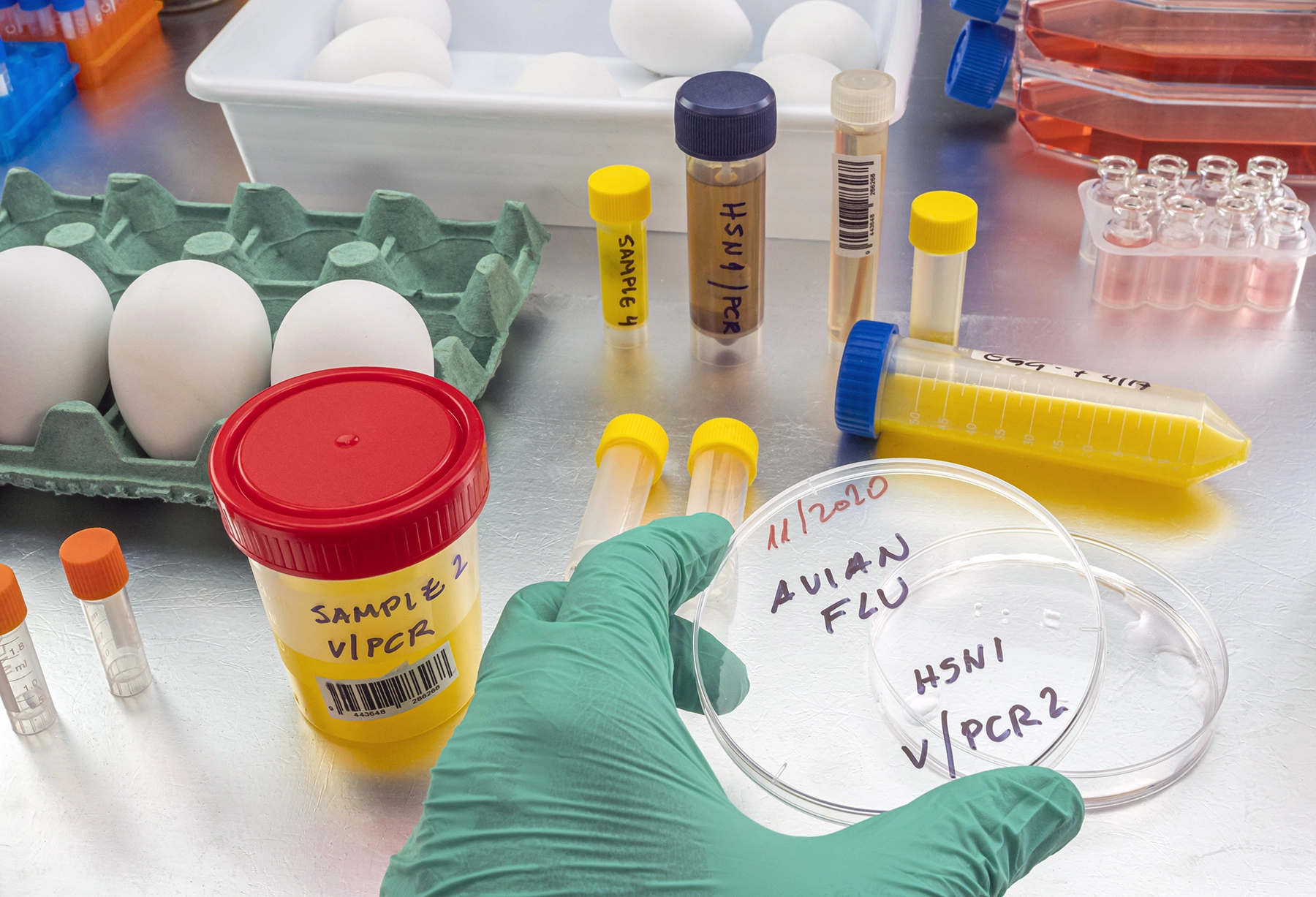Bird Flu Outbreak: What We Know Now

The recent U.S. outbreak of a highly pathogenic strain of avian flu (HPAI H5N1) is making headlines because the pathogen has been transmitted from wild birds to dairy cattle for the first time.
The virus, commonly called “bird flu,” typically spreads among wild aquatic birds and infects some domestic birds and animals. The description “highly pathogenic” refers to the virus’s impact on birds, not necessarily humans or other mammals.
Normally, bird flu does not infect humans.
But, during this current outbreak, several commercial dairy workers in Michigan and Texas who were not wearing personal protective equipment (PPE) caught the virus from close contact with infected dairy cattle. These individuals experienced mild eye infections and have since recovered. There are no reports of non-farmworkers currently infected with the avian flu in the United States.
This transmission from bird to cow to human has sparked widespread concerns about the safety of commercial chickens, their eggs, and unpasteurized cow milk.
What is being done to protect the public from another viral pandemic?
U.S. governmental agencies, including the Food and Drug Administration (FDA) and the U.S. Department of Agriculture (USDA), are testing these food products for traces of H5N1 and are frequently sharing updates about the findings and any known risks to the public.
According to the FDA, as of June 6, 2024, a study of 297 retail dairy samples was found to be “negative for viable virus.” All final egg inoculation tests associated with this sample were also found to be “negative for viable HPAI H5N1 virus.”
The word “viable” is important here because it refers to a living virus that may infect others. Traces of H5N1 have been found in the public milk supply, and after further testing, they were found to be inactive viral remnants that cannot make people sick.
The FDA is continuing to take and test additional samples while employing other surveillance methods to identify the sources and track the spread of the virus.
Is it safe to eat poultry and eggs today?
Yes, it’s still safe to eat store-bought chicken, turkey and eggs as long as you properly prepare and cook them, according to the USDA. “Avian influenza is not transmissible by eating properly prepared poultry, so properly prepared and cooked poultry and eggs are safe to eat.” This includes keeping these food products at a safe temperature before, during and after cooking.
The agency also states that the chance of infected poultry entering the retail food chain (grocery stores and restaurants) is extremely low. “As part of the USDA highly pathogenic avian influenza response plan, infected birds do not enter the food supply.
Additionally, USDA’s Food Safety and Inspection Service inspection program personnel are assigned to every federally inspected meat, poultry and egg product plant in America. All poultry products for public consumption are inspected for signs of disease both before and after slaughter.”
Is it still safe to enjoy milk and cheese?
Both the FDA and the USDA claim that the U.S. commercial dairy milk supply is safe. This is due to the pasteurization process and the diversion/destruction of milk from sick cows. Similarly, the FDA does not currently have concerns about the safety of pasteurized dairy products, like cheese and sour cream. When dairy milk is pasteurized, it’s heated to a specific temperature for a set period of time to kill harmful bacteria and viruses, making it safer for human consumption.
The FDA advises against the consumption of raw milk because it has not been pasteurized. High levels of A(H5N1) virus have been found in unpasteurized milk from H5N1-infected cows.
While animals infected with avian influenza viruses may have virus present in their milk, there is no known case of transmission from commercial dairy milk to humans.
How does bird flu spread?
According to the U.S. Centers for Disease Control and Prevention, the way bird flu can transmit from animal to human is similar to that of COVID-19. But, the spread of avian flu from infected people to other people has been extremely rare.
“Human infections with avian influenza viruses can happen when the virus gets into a person’s eyes, nose or mouth, or is inhaled. This can happen when the virus is in the air (in droplets, small aerosol particles, or possibly dust) and deposits on the mucus membranes of the eyes or a person breathes it in, or possibly when a person touches something contaminated by viruses and then touches their mouth, eyes or nose.”
This is why transmission has historically occurred only when people come in close contact with an infected bird, duck or mammal.
The CDC acknowledges “the possibility that bird flu viruses could change and gain the ability to spread easily between people.” The U.S. government and public health organizations will continue to closely monitor the situation and report new developments in a massive effort to slow the spread of this virus among animals and prevent the transmission to people.
Medically reviewed by Maria Luisa Alcaide, M.D., an infectious disease expert at UHealth.
Dana Kantrowitz is a contributor for UHealth’s news service.
Sources:
CDC Technical Report: June 2024 Highly Pathogenic Avian Influenza A(H5N1) Viruses: https://www.cdc.gov/bird-flu/php/technical-report/h5n1-06052024.html?CDC_AAref_Val=https://www.cdc.gov/flu/avianflu/spotlights/2023-2024/h5n1-technical-report-06052024.htm
CDC Reports Second Human Case of H5 Bird Flu Tied to Dairy Cow Outbreak, May 22, 2024: https://www.cdc.gov/media/releases/2024/s0522-human-case-h5.html
FDA Updates on Highly Pathogenic Avian Influenza (HPAI), June 6, 2024: https://www.fda.gov/food/alerts-advisories-safety-information/updates-highly-pathogenic-avian-influenza-hpai
USDA Questions and Answers, Food Safety and Avian Influenza, April 2015: https://www.usda.gov/sites/default/files/documents/avian-influenza-food-safety-qa.pdf
Questions and Answers Regarding Milk Safety During Highly Pathogenic Avian Influenza (HPAI) Outbreaks, April 24, 2024: https://www.fda.gov/food/milk-guidance-documents-regulatory-information/questions-and-answers-regarding-milk-safety-during-highly-pathogenic-avian-influenza-hpai-outbreaks
CDC, Bird Flu Virus Infections in Humans: https://www.cdc.gov/flu/avianflu/avian-in-humans.htm
Tags: avian flu, Dr. Maria Alcaide, impact on humans, infectious
